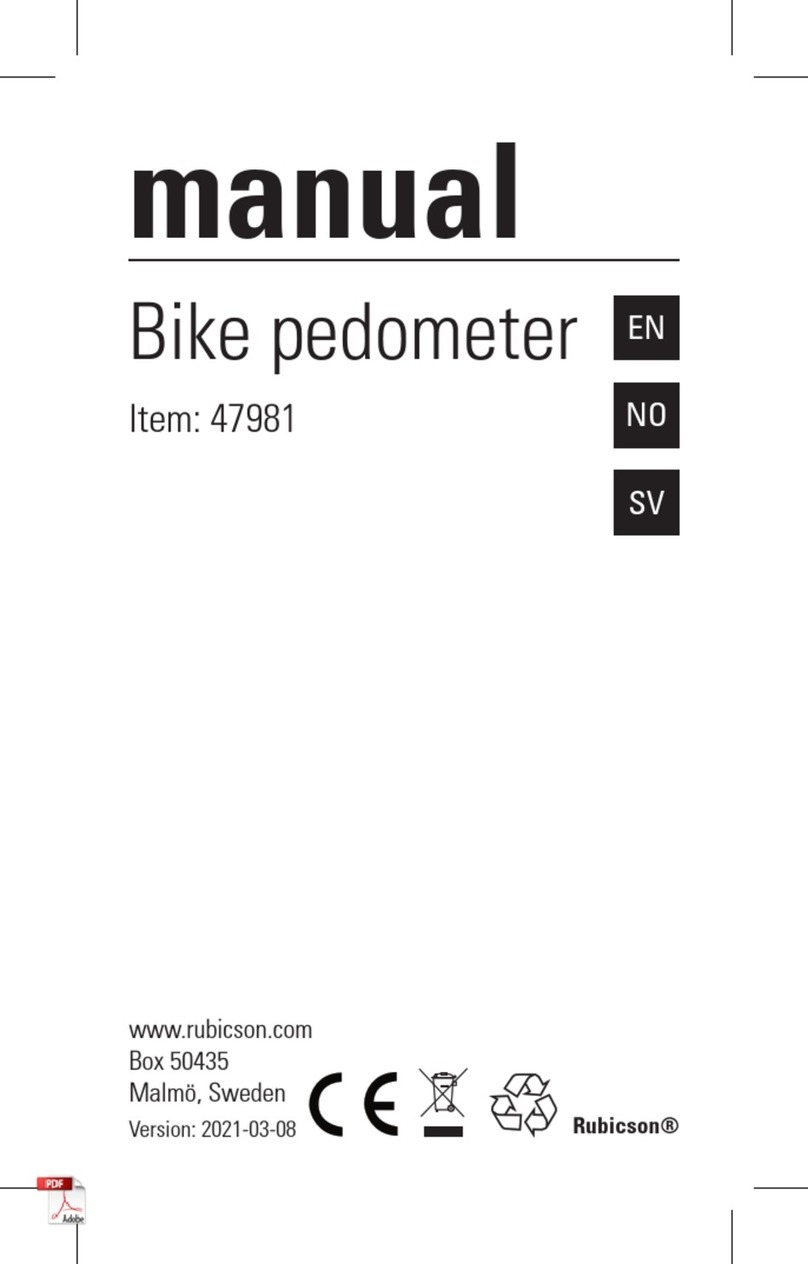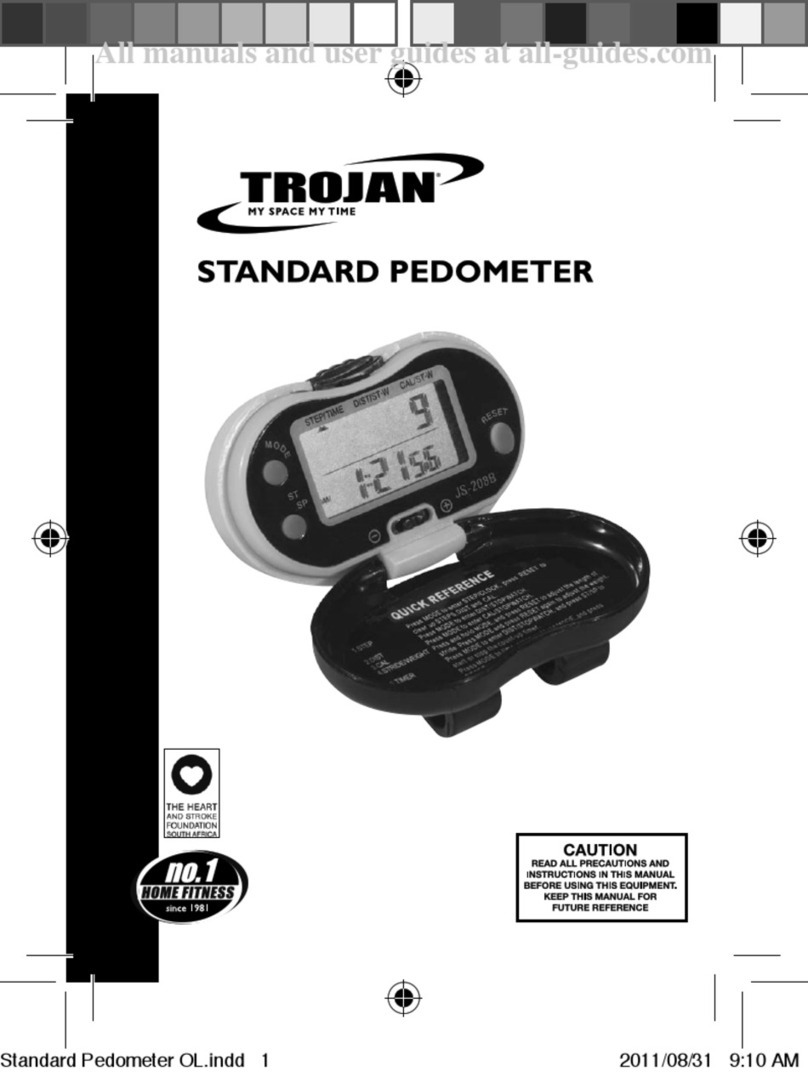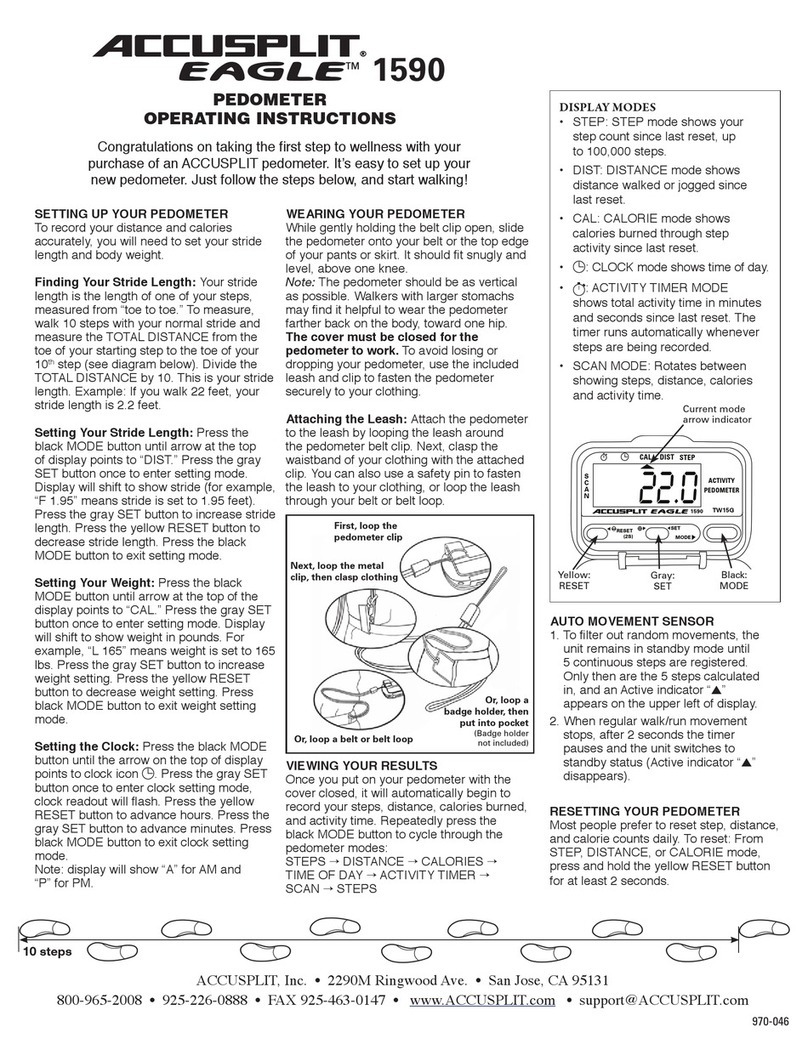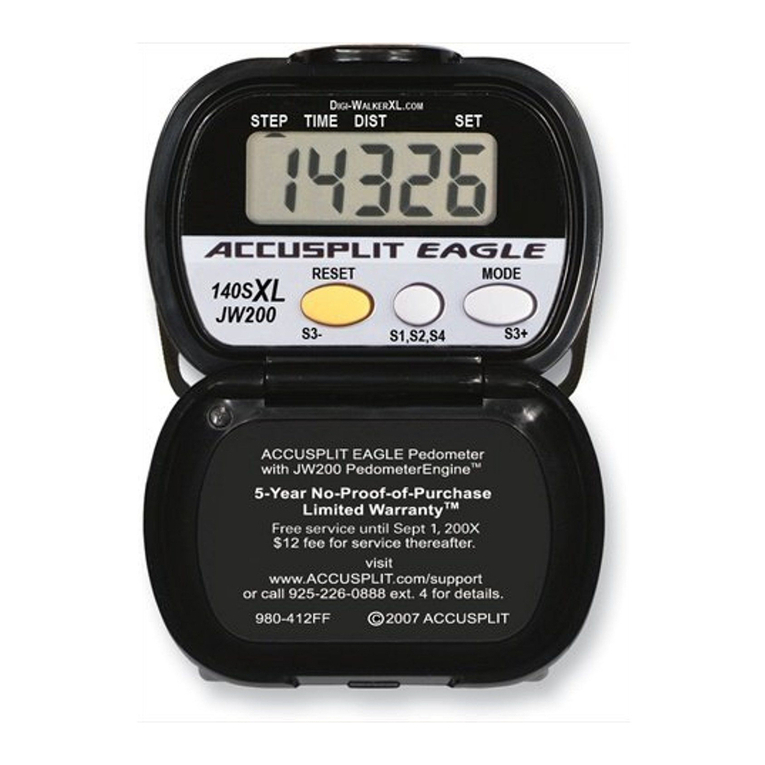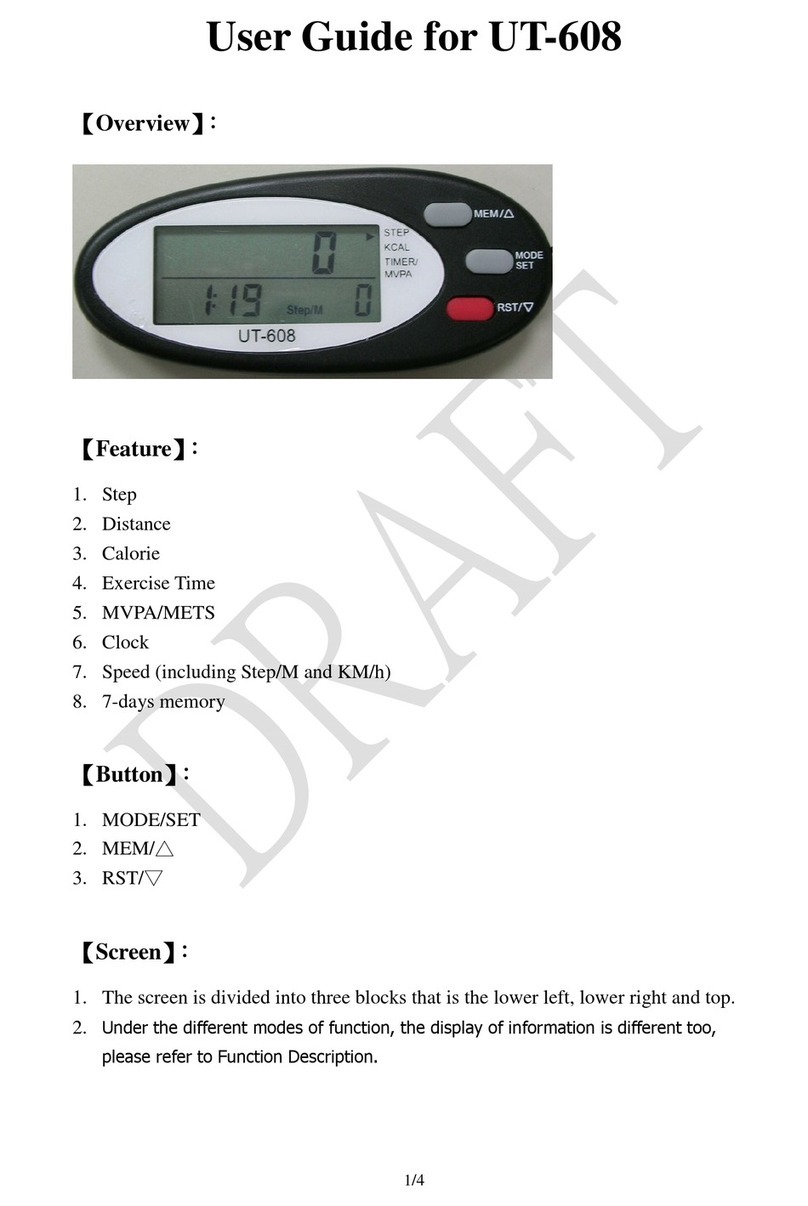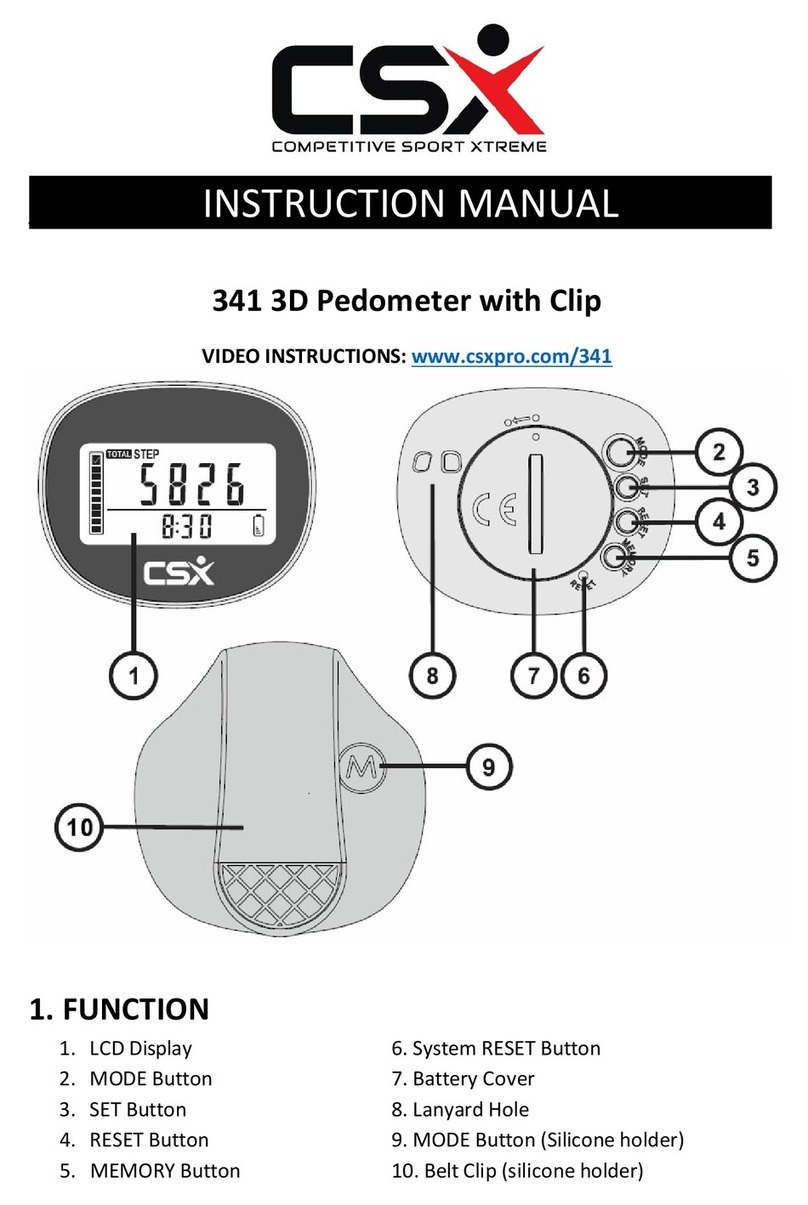NEW LIFESTYLES SW-700 DIGI-WALKER User manual

Note: Assuming that you wear your NEW
LIFESTYLES DIGI-WALKER™ pedometer correct-
ly and understand how it works, your pedome-
ter will accurately measure — within 1% — the
actual number of steps you take.
A pedometer measures the vertical acceleration
— up and down motion — of your hip as you
walk. It also measures other things you do
throughout your day — bending to tie your
shoes, going up and down stairs, etc. That’s
OK, because the goal of the 10,000 steps pro-
gram is for you to expend more energy and
burn more calories. For more information about
incorporating physical activity into your day, visit
www.new-lifestyles.com.
Inside your pedometer is a mechanism that
includes a suspended arm (like a clock pendu-
lum). To work properly, that arm must be
upright. So, if you find that your pedometer
isn’t measuring all your steps, the arm probably
isn’t upright. If your pedometer tilts much, the
arm will not move properly and the pedometer
will not register steps correctly.
Try experimenting with the positioning of your
pedometer to ensure the arm is upright and the
device is correctly counting your steps.
Frequently Asked Questions
1. I hear something moving inside my
pedometer. Is that normal?
Yes. That’s the suspended lever arm, which
moves up and down as you move. You’ll
notice that the lever arm counts “steps”
when you shake or move the pedometer.
That, too, is normal –– but it’s not a very
healthy way to get your steps in!
2. Will my pedometer work properly if it’s
in my pocket?
No. To work properly, your pedometer must
be in an upright, vertical position.
3. Will my pedometer work if I run?
Yes, it works for running, but you’ll need to
set a stride length that corresponds to your
pace if you want your distance meter to be
accurate. When finished, you will want to
re-enter your walking stride length.
4. How does the pedometer know how
far I’ve gone?
The SW-700 multiplies the number of steps
you take by the stride length you enter and
then displays the result in kilometers.
Therefore, if you want your distance meas-
urement to be accurate, it is important to
enter an accurate stride length.
5. I don’t think my pedometer is working
properly. What should I do?
Refer to the Troubleshooting suggestions on
the inside of this pamphlet, or visit the FAQ
section of www.new-lifestyles.com.
Instructions for
Pedometer Use
How to Open Your Pedometer
With your pedometer attached to your waist or
held upright in your hand, grasp the top of the
clip with one hand and use the other hand to
push the door away from the clip.
How to RESET Your Pedometer
To clear the data recorded in your pedometer
— other than stride length — push the RESET
button.
Unless you are measuring a cumulative weekly
total, you should clear your total each night
when you take off your pedometer.
USING YOUR NEW LIFESTYLES
SW-700 DIGI-WALKER™PEDOMETER
©2002 NEW LIFESTYLES, INC. For more information, visit www.new-lifestyles.com
12
Thank you for choosing NEW LIFESTYLES!
A Step Above the Rest™

How to Determine Your Stride
Length
When walking, your stride length is the dis-
tance from the toe of your front foot to the toe
of your back foot (or the heel of the front foot
to the heel of the back foot).
Before you can program stride length into your
pedometer, you must determine it. To do this,
you must walk or run a given (measured) dis-
tance while counting the number of steps it
takes to travel that distance. (Your goal here is
simply to find your average stride length.)
Note: You can measure a distance using your
car, but it won’t be as accurate. You also can
use a treadmill if it’s calibrated accurately
(which isn’t always the case).
Here are two easy methods for measuring
stride length:
1. Lap-Around-Track Method
This is the most accurate method.
1. Go to a college or high school track.
2. Find out the distance of the track. (Most
outdoor tracks are 400 meters, although
some indoor tracks are 200 meters.)
3. Walk around the inside lane once, counting
the number of steps you take. (Or, let your
pedometer do the counting for you!)
4. Divide the length of the track by the num-
ber of steps you took.
5. Convert from meters to centimeters.
6. Round to the nearest centimeter. The
answer is your stride length.
Example: Terry took 500 steps around a
400-meter track. 400 meters divided by
500 steps is .8 meters/step. Move the deci-
mal point two places (to convert to cen-
timeters). Terry’s stride length is 80 cen-
timeters/step.
Note: The pedometer should be vertical,
with the clip against your body. When you
open the door, the screen should face you.
2. If your pedometer is equipped with a secu-
rity strap, attach the strap’s clip onto a belt
loop, waistband or belt –– or to a bunched-
up piece of nearby material. To order a
security strap, visit www.new-lifestyles.com
and click Catalog.
Note: Never secure the pedometer to your
clothing with only the security strap.
3. Take the 20 Steps Test (see box at right) to
make sure you’ve placed your pedometer
correctly.
Troubleshooting
Additional problems and their suggested
solutions can be found at
www.new-lifestyles.com/faq.html.
1. DIGI-WALKER™pedometer falls in water
or goes through washing machine
While it is not recommended, pedometers have
been known to survive a trip through the wash-
ing machine or a dip in the toilet. However, the
heat from a dryer is usually detrimental. Try this:
1. Remove the battery.
2. Let the unit dry out for at least 24 hours.
3. Replace battery.
2. Display is stuck on one number
There are a few things to try in this situation:
1. Perform a self-test.
•Hold down all the buttons simultane-
ously for five seconds.
•When the display goes blank, remove
your fingers from the buttons.
•Your display should show “88888” and
then “0.” If not, continue to Step 2.
2. Remove the battery. Note: Removing the
battery will clear all your settings.
3. Put the battery back in. Your display should
read “0.”
3. Display looks dim
When the display looks dim, your battery is low.
Here’s how to change the battery:
1. Obtain a LR-44 battery (try discount, office
supply or watch/camera stores).
2. Open the back of the pedometer:
•Place a coin in the slot on the bottom
of the pedometer.
•Turn the coin and snap the cover open.
•Gently lift the
cover.
•Replace the
“dead” battery
with the new
one, making
sure the “+”
sign faces you.
•Replace the
cover, making
sure it is properly
aligned before
you snap it shut.
•Make sure the
cover is secure.
3. Perform a self-test
(see situation #2).
4. LCD is blank or shows strange characters
Your LCD display is probably broken as the
result of a drop or direct hit.
Warning: Some people have broken the clips
on their pedometers (see below) by catching
their pedometer while shutting the car door.
Be careful!
5. Clip is broken
When you force your clip onto or off a waist-
band that is too thick, or catch it on something
that pulls it away from your body, you can
break the plastic. If this happens, then email
info@digiwalker.com for your options.
Understanding the
Display
Used to set stride
length & weight
Clears totals
Displays up to
99,999 steps,
999.99 km, &
9,999.99 kcals
Used to switch
between steps,
distance &
calories
2. The 10-Steps Method
This method yields fairly accurate results.
1. Mark a starting point on the ground.
2. With the fronts of your shoes at the start-
ing point, stand with your feet together.
3. Take 10 steps and stop.
4. Mark your stopping point on the ground
(the point at the fronts of your shoes).
5. Measure the distance traveled in
centimeters.
6. Divide the number of centimeters you
traveled by 10 (the number of steps you
took).
How to Set Your Stride Length
1. Calculate your stride length.
2. Press MODE until the cursor at the top of
the screen points to DIS (km).
3. Press SET. The cursor will “jump” to STRIDE.
4. Continue to press the SET button until your
stride length appears.
5. Press MODE until it returns to STEP.
How to Set Your Weight
1. Press MODE until the cursor points to
CALORIE.
2. Press SET. The cursor will “jump” to
WEIGHT.
3. Continue to press SET until your weight
appears. Note: Weight can be set from 30
to 120 kg.
How to Wear Your
Pedometer
For accurate and reliable
readings, you must wear
your pedometer correctly.
NOTE: If you have a
protruding tummy, you
may need to position your
pedometer more on your
side.
Otherwise, your stomach may lean into the
pedometer, forcing it out of its correct
position.
1. With the NEW LIFESTYLES decal facing out,
slide the clip onto a belt, waistband or hori-
zontally hemmed pocket –– halfway
between your belly button and hip.
The 20 Steps Test
Take this simple test to find out whether
you’ve found a good placement on your
body for your pedometer:
1. Wearing your pedometer as explained
previously, press RESET.
2. Walk 20 steps.
3. Without taking the pedometer off, open
the door and check the number of steps
it registered.
4. If it doesn’t read 19 to 21 steps, move
the pedometer to a different spot on
your waistband and repeat until you find
the most accurate position.
battery
Need warranty/guarantee info? Visit www.new-lifestyles.com. Click Catalog and then Warranty Info.
Table of contents
